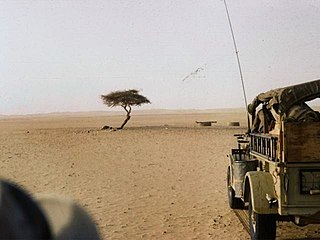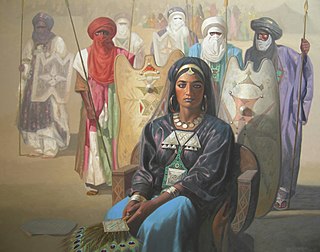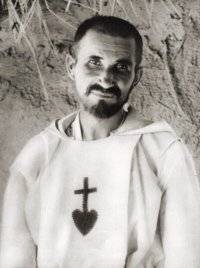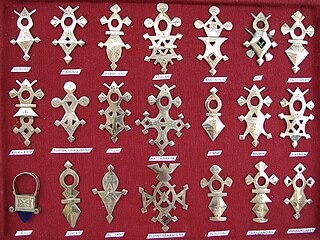Related Research Articles

The Berber languages, also known as the Amazigh languages, are a branch of the Afroasiatic language family. They comprise a group of closely related languages spoken by the Berbers, who are indigenous to North Africa. The languages were traditionally written with the ancient Libyco-Berber script, which now exists in the form of Tifinagh.

Tifinagh is an abjad script used to write the Berber languages.

The Tuareg people are a large Berber ethnic group that principally inhabit the Sahara in a vast area stretching from far southwestern Libya to southern Algeria, Niger, Mali, and Burkina Faso. Traditionally nomadic pastoralists, small groups of Tuareg are also found in northern Nigeria.

The Tuareg languages constitute a group of closely related Berber languages and dialects. They are spoken by the Tuareg Berbers in large parts of Mali, Niger, Algeria, Libya and Burkina Faso, with a few speakers, the Kinnin, in Chad.

The Ténéré Tree was a solitary acacia, that was once considered the most isolated tree on Earth—the only one for over 150 kilometres (93 mi). It was a landmark on caravan routes through the Ténéré region of the Sahara Desert in northeast Niger, so well known that it and the Arbre Perdu to the north are the only trees to be shown on a map at a scale of 1:4,000,000. The Tree of Ténéré was located near a 40-metre (130 ft) deep well. It was knocked down in 1973 by a truck driver.

Tin Hinan was a 4th-century Tuareg queen. Her monumental tomb is located in the Sahara, at Abalessa in the Hoggar region of Algeria.

Henri Duveyrier was a French explorer and geographer, known for his exploration of the Sahara.

Charles Eugène de Foucauld was a cavalry officer in the French Army, then an explorer and geographer, and finally a Catholic priest and hermit who lived among the Tuareg in the Sahara in Algeria. He was assassinated in 1916 and is considered by the Church to be a martyr. His inspiration and writings led to the founding of the Little Brothers of Jesus among other religious congregations.
The Berber Latin alphabet is the version of the Latin alphabet used to write the Berber languages. It was adopted in the 19th century, using varieties of letters.

The Tuareg Rebellion of 2007–2009 was an insurgency that began in February 2007 amongst elements of the Tuareg people living in the Sahara desert regions of northern Mali and Niger. It is one of a series of insurgencies by formerly nomadic Tuareg populations, which had last appeared in the mid-1990s, and date back at least to 1916. Populations dispersed to Algeria and Libya, as well as to the south of Niger and Mali in the 1990s returned only in the late 1990s. Former fighters were to be integrated into national militaries, but the process has been slow and caused increased resentment. Malian Tuaregs had conducted some raids in 2005–2006, which ended in a renewed peace agreement. Fighting in both nations was carried on largely in parallel, but not in concert. While fighting was mostly confined to guerrilla attacks and army counterattacks, large portions of the desert north of each nation were no-go zones for the military and civilians fled to regional capitals like Kidal, Mali and Agadez, Niger. Fighting was largely contained within Mali's Kidal Region and Niger's Agadez Region. Algeria helped negotiate an August 2008 Malian peace deal, which was broken by a rebel faction in December, crushed by the Malian military and wholescale defections of rebels to the government. Niger saw heavy fighting and disruption of uranium production in the mountainous north, before a Libyan backed peace deal, aided by a factional split among the rebels, brought a negotiated ceasefire and amnesty in May 2009.
Tetserret is a Western Berber language spoken by the Ait-Awari and Kel Eghlal Tuareg tribes of the Akoubounou (Akabinu) commune in Niger. This main speech area is located between Abalak, Akoubounou and Shadwanka. The variant spoken by the Kel Eghlal is called taməsəɣlalt. The Tamasheq equivalent shin-sart / shin-sar / tin-sar is used in some older literature. Popular understanding among some Ait-Awari derives the name tet-serret, and its Tamasheq equivalent shin-sart, from expressions meaning 'the (language) of Sirte'.
The Berber Academy is a cultural association founded in 1966 by Mohand Arav Bessaoud and a group of young Kabyles, including Ramdane Haifi. This group consisted of intellectuals, artists and journalists, all eager to put the Tifinagh in use. Fearing misuse of the term "academy", they renamed the association Agraw Imaziɣen in 1967. This was dissolved in 1978.
Bankilaré is a village and rural commune in Niger. Bankilaré commune, centered on the town of the same name, is in Téra Department, Tillabéri Region, in the northwestern corner of the country. The town lies 60 km north of Departmental capital Téra, and around the same distance from the Burkina Faso border and the Mali border.
Rhissa Ag Boula is a Nigerien Tuareg politician and former leader of rebel factions in both the 1990–1995 and the 2007–2009 Tuareg based Insurgencies. He was Nigerien Minister of Tourism from 1996-1999, and again from 1999-2004. His arrest on murder charges in 2004 precipitated armed conflict between his supporters and the Nigerien government. A political leader following the 1995 peace, he again joined a rebel faction from abroad in 2007, creating his own faction from abroad in 2008, and joining the peace process in 2009. In 2010 he was again arrested after returning to Niger.

Brigi Rafini is a Nigerien politician who served as the Prime Minister of Niger from 2011 to 2021. A native of Iférouane in Agadez Region and an ethnic Tuareg, Rafini was Minister of Agriculture in the late 1980s and Fourth Vice-President of the National Assembly of Niger from 2004 to 2009. He was appointed as Prime Minister after Mahamadou Issoufou took office as President on 7 April 2011. He is also notably the first Tuareg in office.
The Dawsahak people, Idaksahak are pastoralist Berbers centered on Ménaka and Inékar town in Menaka Cercle and Talataye in Ansongo Cercle of the Gao Region of northeastern Mali. They speak the Northern Songhai language Tadaksahak. Many also speak Western Tawallammat Tamajaq language, the Tuareg language of southern Gao. Daoussahak appears to be the most common transliteration of the collective name among French and English academics.
Lazaret is a northern suburb of Niamey, Niger. It is best known historically for its refugee camp with many Tuareg people. The camp became the largest in the Sahel during the extreme drought of 1973-1975.

The Tin Hinan Tomb is a monumental tomb located at Abalessa in the Sahara, in the Hoggar Mountains of southern Algeria. The sepulchre was built for Tin Hinan, the Tuareg ancient Queen of the Hoggar (Ahaggar).

Hawad, sometimes Mahmoudan Hawad, is a Tuareg poet and author born in the Aïr region of Niger and who currently lives and publishes from Aix-en-Provence, France. Hawad deploys a method he calls furigraphy to create space in his poetry and to illuminate certain themes. Common themes of his work include thirst, movement, wandering, anarchy, and political themes related to Tuareg politics in the region. He is married to Hélène Claudot-Hawad, a Tuareg scholar and translator of Hawad's poetry into French. He has published a number of poems, epics, and other literary works primarily in French, but translations have increased in recent years with an Arabic translation of Testament nomade by prominent Syrian poet Adunis.

The Agadez Cross is the most popular category of Saharan Berber jewelry made especially by the Tuareg people of Niger. Only a few of this jewelry really looks like a cross. For most of them, it is a pendant with a varied silhouette, related either to a cross (tanaghilt), or to a form of plate or shield (talhakim). The former is made of stone or copper. The blacksmiths generally use silver and the so-called "lost wax" casting process without ever hammering the metal.
References
- ↑ Rivaillé, Laurence (1993). Contes et légendes touaregs du Niger: des hommes et des djinns (in French). KARTHALA Editions. p. 9. ISBN 9782865374236.
- ↑ Rivaillé, Laurence (1993). Contes et légendes touaregs du Niger: des hommes et des djinns (in French). KARTHALA Editions. p. 16. ISBN 9782865374236.
- ↑ Rivaillé, Laurence (1993). Contes et légendes touaregs du Niger: des hommes et des djinns (in French). KARTHALA Editions. p. 42. ISBN 9782865374236.
- ↑ Rivaillé, Laurence (1993). Contes et légendes touaregs du Niger: des hommes et des djinns (in French). KARTHALA Editions. pp. 15–46. ISBN 9782865374236.